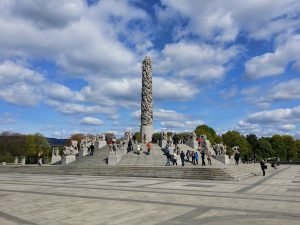
Mystical Norse Goddesses: Divine Legends Unveiled
Have you ever wondered about the captivating and powerful Norse goddesses who dwell within the realms of Norse mythology? From tales of love and beauty to fierce battles and acts of protection, these divine beings have left an indelible mark on the ancient Norse culture. Let’s embark on a journey to explore the secrets and legends behind these awe-inspiring goddesses, as we uncover the mysteries of their existence.
Table of Contents
ToggleKey Takeaways:
- Delve into the captivating world of Norse goddesses in Norse mythology
- Discover the remarkable roles these powerful goddesses played
- Unravel the significance behind symbols and representations associated with Norse goddesses
- Explore the love and passion embodied by the Norse goddesses of love
- Learn about the fierce and formidable Norse goddesses of war
The Mighty Goddesses of Asgard
Step into the enchanting realm of Norse mythology and meet the mighty goddesses of Asgard. Each goddess possesses her unique name and attributes, contributing to the rich tapestry of Norse folklore. Let’s explore the remarkable roles these divine beings played in shaping the pantheon and the world around them.
Freya – Goddess of Love and Beauty
Freya, the goddess of love and beauty, captivates all who encounter her ethereal presence. Known for her enchanting allure and mystical powers, Freya represents the embodiment of desire and passion. With her falcon feather cloak and golden Brisingamen necklace, Freya instills a sense of longing and devotion in the hearts of mortals and gods alike.
Frigg – The Powerful Queen of Asgard
Frigg reigns as the queen of Asgard, embodying wisdom, foresight, and maternal strength. As Odin’s wife, she holds considerable influence in the divine realm, shaping the destiny of gods and mortals alike. Known for her ability to see the future, Frigg’s guidance and protection are sought after by all who seek stability and prosperity.
Hel – Ruler of the Underworld
Hel, the goddess of the underworld, presides over the realm of the dead and outcasts. Half beautiful maiden and half decaying corpse, Hel represents the duality of life and death. As the ruler of the icy underworld, she holds dominion over souls seeking eternal peace or punishment. Hel reminds us of the delicate balance between light and darkness.
Sif – Goddess of Fertility and Harvest
Sif, the goddess of fertility and harvest, nurtures the earth’s bounty and ensures prosperity for all. With her golden hair and gentle demeanor, Sif symbolizes the cycles of growth and abundance. Married to Thor, the mighty god of thunder, Sif’s presence brings fertility to the fields and blessings to those who cultivate the land.
These are just a few of the powerful Norse goddesses who shape the mythology and culture of the Viking era. Their stories and attributes continue to inspire and captivate us, reminding us of the complex and intricate nature of the divine.
| Goddess | Domain | Symbol |
|---|---|---|
| Freya | Love and Beauty | Falcon feather cloak, Brisingamen necklace |
| Frigg | Wisdom and Maternal Strength | Spindle, distaff, and weaving tools |
| Hel | Underworld and Death | Half beautiful, half decaying corpse |
| Sif | Fertility and Harvest | Golden hair |
Symbols and Representations of Norse Goddesses
Discover the fascinating symbols and representations associated with Norse goddesses. These icons provide insight into the unique characteristics and powers of these divine beings, enhancing our understanding of Norse mythology.
The Magical Necklace: Brisingamen
One of the most well-known symbols of Norse goddesses is Brisingamen, the magical necklace belonging to Freya, the goddess of love and beauty. Crafted by the dwarves, this exquisite piece of jewelry symbolizes Freya’s allure and charm. Legend has it that the necklace possesses the ability to bring love and fertility to those who possess it.
The Winged Helmets of Valkyries
The Valkyries, powerful warrior goddesses who serve Odin, are often represented wearing winged helmets. These helmets symbolize the Valkyries’ role as guides of fallen warriors to Valhalla, the great hall of the slain. The wings on the helmets evoke the Valkyries’ ability to soar through the skies, choosing brave warriors who will fight alongside the gods during Ragnarok, the final battle.
“Symbols and representations offer a visual language through which we can explore the essence and powers of Norse goddesses.”
The symbolism associated with Norse goddesses extends beyond Brisingamen and winged helmets, with each goddess having their own unique symbols and representations. Thor’s Hammer, Mjolnir, symbolizes power and protection, while Skadi, the goddess of winter, is often depicted with her bow and arrows, representing her role as a skilled hunter.
By understanding the symbols and representations of Norse goddesses, we gain a deeper appreciation for their significance in Norse mythology. These symbols serve as a connection between the divine and the mortal, bridging the gap between the realms and imparting wisdom and guidance to those who seek it.
Continue to Section 4 to explore the captivating stories of the Norse goddesses of love…
Love and Passion: Norse Goddesses of Love
Step into a world of enchanting tales and fervent desires with the Norse goddesses of love. Led by Freya and Sif, these powerful goddesses hold the key to unraveling the complexities of love, romance, and fertility in Norse mythology.
Freya: The Alluring Goddess of Love and Beauty
“Her name rolls off the tongue with the sweetness of honey, and her beauty rivals that of the most radiant sunrise.”
Freya, the epitome of alluring grace and sensuality, captivates both gods and mortals alike. As the ruler of Fólkvangr, the realm of love, she embraces the pleasures of passion and desire. Known for her exceptional beauty, Freya’s essence permeated every corner of Norse mythology. She enchanted all who beheld her, casting powerful spells with a whisper and igniting the flames of love in the hearts of those who yearned for her affection.
But Freya’s enchanting allure is not confined to romance alone. She is also a proficient practitioner of seidr, the Norse magical tradition. With her formidable powers, Freya shapes the energies of love and sexuality, fostering fertility and ensuring the continuation of life. Her golden tears, shed over her lost husband, Odin, are said to transform into amber, bestowing vitality and prosperity to the earth.
Sif: The Radiant Guardian of Fertility and Harvest
“Her shimmering hair, gleaming in the sunlight, is as radiant as the fields she blesses with abundance.”
Sif, the goddess of fertility and the harvest, adorns the fields with her vibrant presence. With her flowing golden hair, she embodies the life-giving power of the earth’s bounty. Sif’s devotion to fostering abundant crops and ensuring a prosperous harvest is unparalleled. Farmers and agriculturalists pay homage to her, recognizing her as the guardian of their livelihoods.
While Sif’s role is primarily associated with fertility and agriculture, her fierce loyalty and love for her husband, Thor, are equally noteworthy. Their union represents the harmonious balance of passion and devotion, where love and war intertwine in the tapestry of Norse mythology.
| Norse Goddesses of Love | Symbols/Attributes |
|---|---|
| Freya | Magical necklace Brisingamen, falcon feather cloak, boar Hildisvíni |
| Sif | Golden hair, wheat sheaves |
Unveiling the Goddesses’ Stories of Love and Desire
These Norse goddesses of love, with their enthralling stories and distinctive strengths, offer a glimpse into the depths of human emotions. From Freya’s pursuit of knowledge through love affairs with gods and giants to Sif’s unwavering dedication to her husband and the abundance of nature, their narratives are intertwined with love, desire, and the intricate fabric of life itself.
Join us in the next section as we shift our focus to the fierce and formidable Norse goddesses of war, exploring the indomitable spirits of these powerful beings who safeguarded the realms with valor and might.
Warriors and Protectors: Norse Goddesses of War
Within the realm of Norse mythology, the powerful Norse goddesses of war are revered as fierce warriors and formidable protectors. One such group of goddesses are the renowned Valkyries, who play a crucial role in battle by selecting fallen warriors to be taken to the afterlife in Valhalla.
These Norse goddesses of war have captivating stories that depict their strength, bravery, and unwavering commitment to safeguarding the Norse pantheon. Their stories are not only a testament to their individual power, but also to the significance of war and protection in Norse mythology.
“The Valkyries, powerful beings adorned in gleaming armor and winged helmets, soar through the skies on their magnificent steeds, searching for fallen heroes on the battlefield. With great pride, they choose the bravest and most honorable warriors, ensuring their place in the divine halls of Valhalla.”
The Valkyries embody the concept of powerful Norse goddesses of war, blazing through the heavens as fierce guardians and bestowers of a glorious afterlife. Their selection process signifies the importance of bravery in battle and the honorable path embraced by fallen warriors.
While the Valkyries stand as iconic figures among Norse goddesses of war, they are not the only ones. Other powerful goddesses, such as Skadi and Sif, possess their own stories of strength and military prowess. Skadi, for example, is known as a skilled archer and hunter, revered for her ability to fend off enemies and protect her kin.
Below, you will find a table summarizing the stories and attributes of some notable Norse goddesses of war:
| Goddess | Story | Attributes |
|---|---|---|
| Valkyries | Select fallen warriors for Valhalla | Fierce, majestic, honorable |
| Skadi | Skilled archer and hunter | Protector, resilient, determined |
| Sif | Goddess of fertility and battle | Brave, powerful, renowned for golden hair |
These stories of Norse goddesses of war provide a glimpse into the rich tapestry of Norse mythology, where divinity intertwines with the realms of battle and protection. As powerful and influential beings, these goddesses continue to captivate and inspire us today.
Conclusion
The captivating myths and enduring symbols surrounding Norse goddesses have left an indelible mark on Norse mythology. From the powerful goddesses of Asgard to the fierce protectors of the pantheon, their stories continue to intrigue and inspire us.
But what relevance do these ancient goddesses hold in modern times? The answer lies in the deep-rooted connection between worshiping Norse goddesses and our culture. By honoring and venerating these divine beings, we tap into a source of strength and wisdom that transcends time.
Worshipping Norse goddesses allows us to embrace their qualities and incorporate them into our daily lives. Whether seeking love and passion like Freya, or embodying the fierce warrior spirit of the Valkyries, these goddesses serve as powerful archetypes for personal growth and empowerment.
As we delve into the realms of Norse mythology and explore the extraordinary tales of Norse goddesses, we gain a greater understanding of ourselves and our place in the world. The influence of Norse mythology endures, reminding us of the power and resilience that lies within us all.
FAQ
Who are some powerful Norse goddesses?
Some powerful Norse goddesses include Freya, Frigg, Hel, Skadi, and Sif.
What are the names of Norse goddesses?
Norse goddesses have various names, such as Freya, Frigg, Hel, Idun, Njord, Ran, Skadi, Sif, and Sigyn.
What are some symbols associated with Norse goddesses?
Symbols associated with Norse goddesses include Freya’s necklace Brisingamen, Valkyries’ winged helmets, Skadi’s snowshoes, and Frigg’s spindle.
Which Norse goddesses are associated with love?
The Norse goddesses associated with love are Freya and Sif.
Who are the Norse goddesses of war?
The Norse goddesses of war include the Valkyries and Skadi. They played significant roles in battles and protecting the Norse pantheon.
If you want to learn Norwegian, you can register for classes here. We look forward to hearing from you and helping you become fluent in Norwegian.




